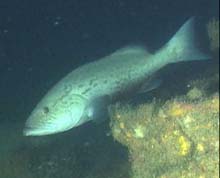Groupers on the Edge
Felicia Coleman, Program Director
Institute for Fishery Resource Ecology
Florida State University
Gag grouper (Mycteroperca microlepis) are currently overfished. The problem is compounded by evidence that male fish are declining in some populations. No males equals no sex, no babies, no fish. No one wants that. Yet resistance to protecting males and grouper populations in general is profound, because protecting males means protecting specific habitats where males reside, and because protecting populations involves protecting spawning sites. It turns out that these sites often form the very heart of the fishery.
Groupers, the dominant predatory fish on many coral reefs, are particularly vulnerable to rapid overfishing because of their reproductive behaviors. First, they have complex social systems that lead them to change sex, and second, they form large groups, called “aggregations,” to spawn for relatively short periods of time. While together in aggregations, the fish are easily caught. Fishers know this and take advantage of this behavior to increase their catches.
Sex change in groupers is a one-way street, from female to male. It occurs in a social context when fish form spawning groups offshore. For gag, this only occurs for a relatively brief period of time, during the late winter or early spring. At other times of the year, males and females occur in separate locations, with males staying offshore while females move to shallower water. Virtually all of the reproduction in the population takes place in the brief time when the sexes are together. So do all of the cues for sex change. Social interactions among individuals in the group allow some sort of assessment to occur of the relative numbers of males and females. If too few males are present, the dominant females will change sex, so that by the following spawning season, more males are available.
When the gags spawn is when these characteristics collide with fishers who target the locations where fish reproduce. The fisher’s advantage of getting larger catches over a shorter period of time -- like the proverbial "fishing in a barrel" -- results in the fishes' rapid decline. Not only are the largest fish removed from the population, but the social cues that trigger sex change are interrupted. Thus, fishing that concentrates on aggregations results in smaller fish with fewer eggs, and, ultimately, leads to even fewer males. This is compounded by the loss of females that are changing sex, because they act more like males than like females, and thus, are more vulnerable to capture. Gag populations in the Gulf of Mexico and throughout the South Atlantic, for example, have 90% fewer males now than they did 30 yrs ago.
How widespread is this phenomenon? A quick review of the status of economically important groupers in the southeastern United States reveals that the most important reef fish species are on the verge of, or are, being overfished. Most of them are grouper, and all of them change sex from female to male. At least two species suffer from low proportions of males in the population, and all of them aggregate to spawn. Two species (Nassau grouper and Goliath grouper, formerly known as jewfish) are already protected from fishing. Two are on the verge of being protected (Warsaw grouper and speckled hind). Finally, 26 grouper species worldwide are being considered for the "vulnerable to extinction" list maintained by the IUCN (International Union for the Conservation of Nature/World Conservation Union).
There are currently no management plans in effect to preserve either the social structure or the natural proportion of males in these fishes. Most management approaches, in fact, fail to address these overwhelmingly important aspects of their reproduction. The most logical tool for protecting these fish is marine reserves, areas of the ocean closed to fishing. This is not a radical or unprecedented idea. All anglers understand and accept the need to protect juveniles, for instance. They throw fingerlings back into streams, in the same way that hunters don’t shoot young deer. The advantage of a marine reserve, or closed area, is that it protects spawning fish. It would also offer specific protection for male gag, which tend to stay on these reproductive sites year-round. Perhaps the strongest two arguments for closing areas essential to protecting these species is that it allows investigation into the natural range of complex behaviors that are otherwise intractable, and that it provides insurance to protect us from our ignorance about natural systems.
Sign up for the Ocean Explorer E-mail Update List.












































